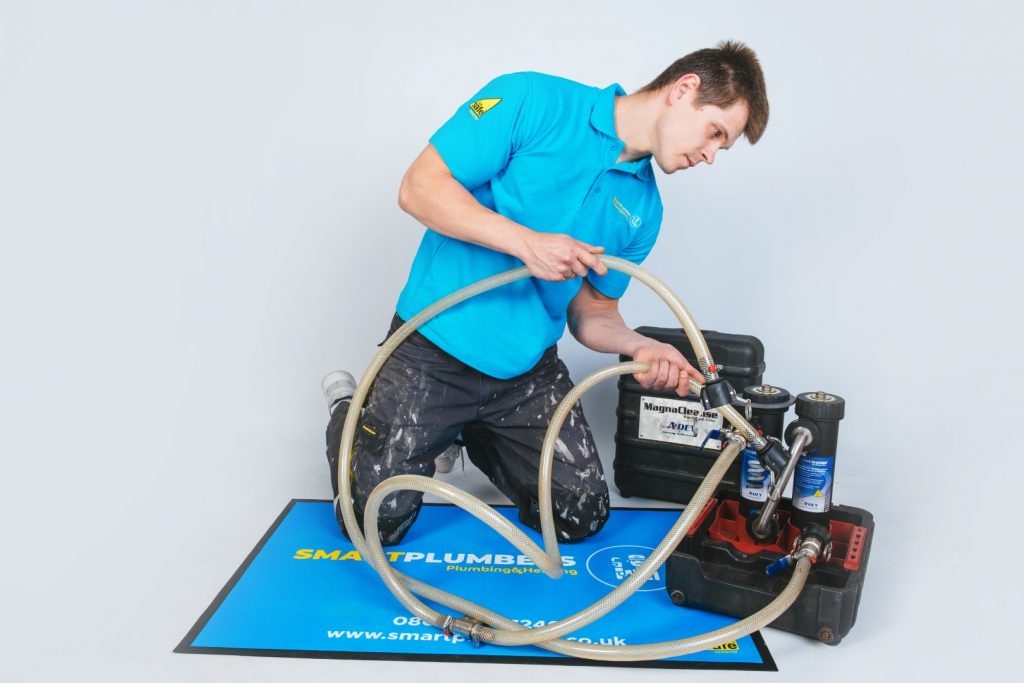
Central Heating Powerflush
All you need to know

If your central heating system isn’t performing at its best, you may have heard of a procedure called a powerflush. A central heating powerflush is a highly effective method to restore and improve the efficiency of your heating system. In this blog post, we will cover everything you need to know about a central heating powerflush, including its benefits, the process involved, signs that indicate you might need one, and why it’s essential to hire a professional for the job.
What is a Central Heating Powerflush?
A powerflush is a thorough cleaning process performed on a central heating system to remove built-up sludge, debris, rust, and other contaminants that can hinder its performance. Over time, these deposits can accumulate in the system, causing blockages, reduced heat output, cold spots on radiators, and even boiler breakdowns. A powerflush is designed to flush out these deposits, restoring the system’s efficiency and improving its overall performance.
The Benefits of a Central Heating Powerflush:
- Improved Heating Efficiency: By removing sludge and debris, a powerflush allows hot water to flow freely throughout the system, maximizing its efficiency and ensuring all radiators heat up evenly.
- Reduced Energy Bills: A clean central heating system operates more efficiently, reducing energy consumption and lowering your heating bills.
- Increased Lifespan of Components: Removing corrosive deposits during a powerflush helps protect vital components, such as the boiler, pump, and radiator valves, from damage, prolonging their lifespan.
- Faster Heating Response: After a powerflush, you’ll notice that your heating system responds more quickly, providing faster heat-up times and a more comfortable living environment.
- Quieter Operation: If your system has been making unusual noises, a powerflush can eliminate the cause by removing air pockets and debris that contribute to the noise.
Signs You Might Need a Powerflush:
Several signs indicate that your central heating system could benefit from a powerflush:
– Cold spots on radiators
– Radiators taking a long time to heat up
– Excessive noise from the boiler or radiators
– Frequent boiler breakdowns or malfunctions
– Fluctuating water temperature
– Poor heat output
– Discolored water when bleeding radiators
The Powerflush Process:
A central heating powerflush typically involves the following steps:
- System Inspection: A professional heating engineer will assess your system’s condition and determine if a powerflush is necessary.
- Isolate and Protect: The engineer will isolate the central heating system, protecting sensitive components and ensuring only the affected parts are subjected to the powerflush process.
- Chemical Treatment: A specially formulated cleaning chemical is added to the system to break down sludge and contaminants. This chemical circulates through the radiators, pipes, and boiler, loosening and removing the deposits.
- Powerflushing: Using a powerful pump and specialized equipment, the engineer flushes clean water through the system at high velocity, dislodging and flushing away the loosened debris.
- Debris Removal: The dirty water containing the dislodged contaminants is safely collected and disposed of outside your property.
- System Refilling: Once the powerflush is complete, the engineer will refill the system, adding a corrosion inhibitor to protect against future build-up and ensure long-term system health.
Why Hire a Professional for a Powerflush?
While it may be tempting to attempt a powerflush as a DIY project, it’s strongly recommended to hire a professional heating engineer for several reasons:
- Expertise and Experience: Professional engineers have the knowledge, skills, and experience to perform a thorough powerflush safely and effectively, minimizing the risk of damage to your system.
- Proper Equipment: Qualified engineers have access to specialized equipment designed specifically for powerflushing, ensuring optimal results.
- System Protection: Professionals understand how to isolate and protect sensitive components during the powerflush process, preventing potential damage.
- Comprehensive Service: A professional powerflush often includes additional checks and maintenance to ensure your system is functioning optimally.
Easy booking backed with a 12-month guarantee
24/7* with no callout charges
Advice Hub
- What to do if you smell gas in your home?
- How to protect yourself from Carbon monoxide: The silent killer?
- Why should I service my boiler?
- How to reduce your Gas bills: Recent increase in energy prices?
- Common boiler fault codes & what they mean?
- What to do if a pipe bursts in your home?
- Going on holiday? Be sure to do these things to avoid a disaster
- 10 tips to protect your home: Gas Safety Week
- Common smart meter problems & How to fix them
- Gas safety regulations: Landlords & Tenants responsibilities
- How to keep water bills down
- Central Heating Powerflush: All you need to know
- 5 common reasons your boiler isn’t working
- Importance of servicing a gas fire
- Common plumbing problems
Conclusion
A central heating powerflush is a highly effective solution for restoring and improving the performance of your heating system.
By removing sludge, debris, and contaminants, a powerflush enhances energy efficiency, prolongs the lifespan of components, and ensures consistent heat distribution throughout your home. To ensure the best results and avoid potential damage, it’s essential to hire a qualified heating engineer who can perform the powerflush professionally and efficiently.
Don’t hesitate to reach out to a trusted professional to discuss your central heating system’s needs and schedule a powerflush for optimal heating performance and long-term system health.









